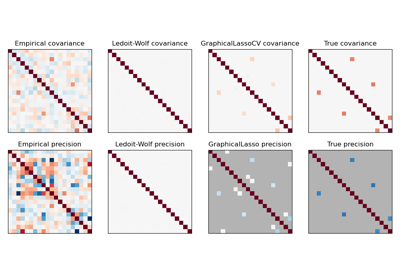make_sparse_spd_matrix#
- sklearn.datasets.make_sparse_spd_matrix(n_dim=1, *, alpha=0.95, norm_diag=False, smallest_coef=0.1, largest_coef=0.9, sparse_format=None, random_state=None)[source]#
Generate a sparse symmetric definite positive matrix.
Read more in the User Guide.
- Parameters:
- n_dimint, default=1
The size of the random matrix to generate.
Changed in version 1.4: Renamed from
dimton_dim.- alphafloat, default=0.95
The probability that a coefficient is zero (see notes). Larger values enforce more sparsity. The value should be in the range 0 and 1.
- norm_diagbool, default=False
Whether to normalize the output matrix to make the leading diagonal elements all 1.
- smallest_coeffloat, default=0.1
The value of the smallest coefficient between 0 and 1.
- largest_coeffloat, default=0.9
The value of the largest coefficient between 0 and 1.
- sparse_formatstr, default=None
String representing the output sparse format, such as ‘csc’, ‘csr’, etc. If
None, return a dense numpy ndarray.Added in version 1.4.
- random_stateint, RandomState instance or None, default=None
Determines random number generation for dataset creation. Pass an int for reproducible output across multiple function calls. See Glossary.
- Returns:
- precndarray or sparse matrix of shape (dim, dim)
The generated matrix. If
sparse_format=None, this would be an ndarray. Otherwise, this will be a sparse matrix of the specified format.
See also
make_spd_matrixGenerate a random symmetric, positive-definite matrix.
Notes
The sparsity is actually imposed on the cholesky factor of the matrix. Thus alpha does not translate directly into the filling fraction of the matrix itself.
Examples
>>> from sklearn.datasets import make_sparse_spd_matrix >>> make_sparse_spd_matrix(n_dim=4, norm_diag=False, random_state=42) array([[1., 0., 0., 0.], [0., 1., 0., 0.], [0., 0., 1., 0.], [0., 0., 0., 1.]])
